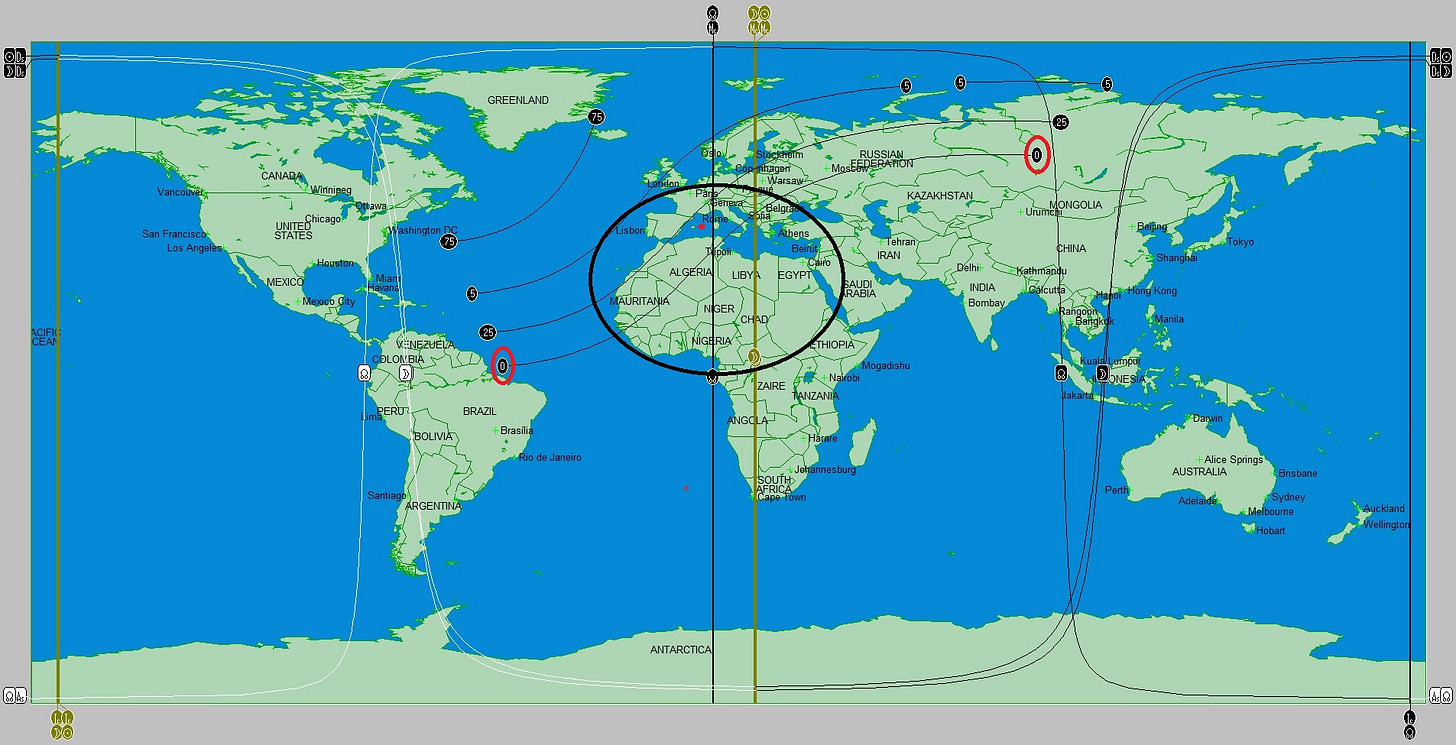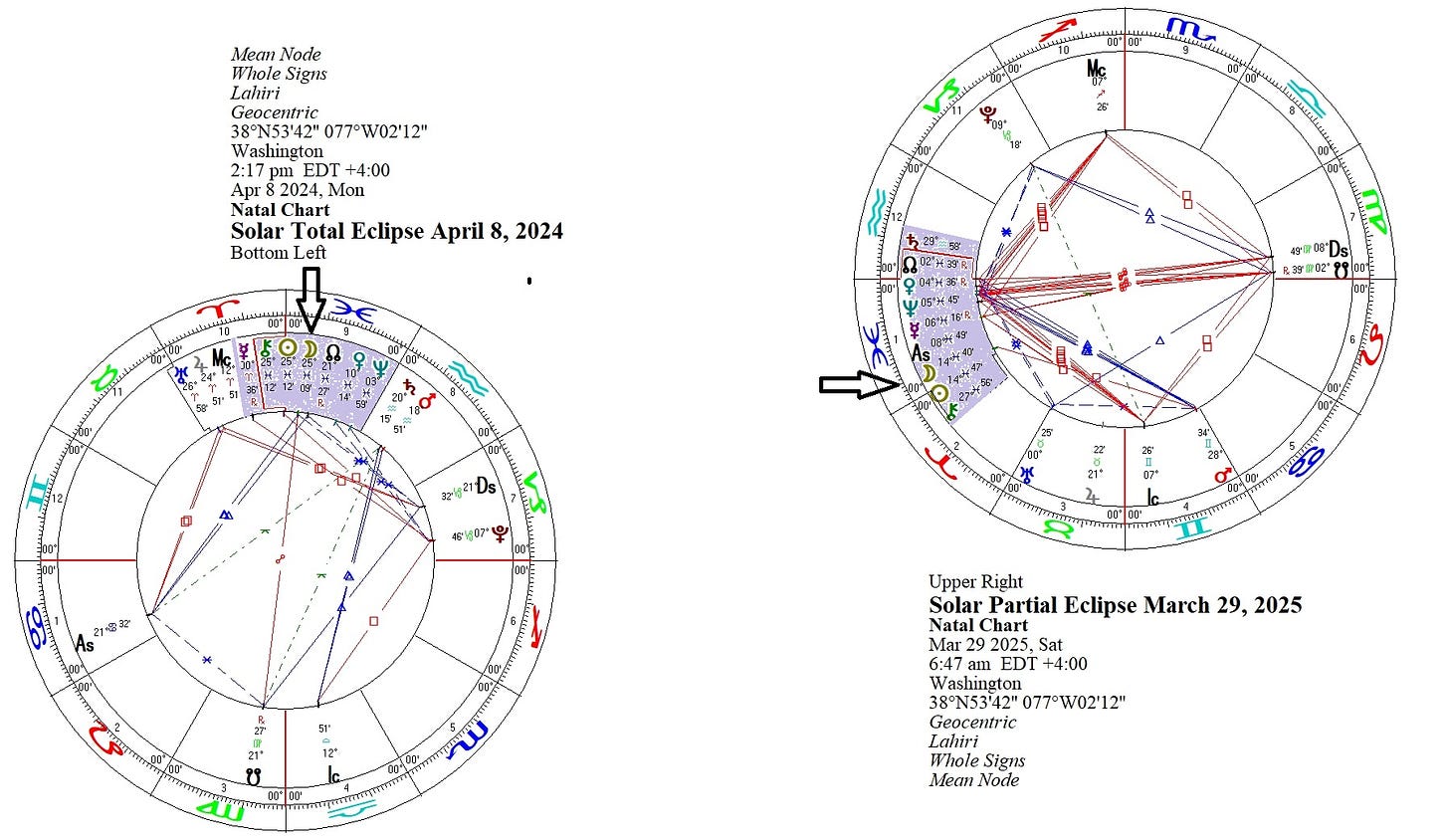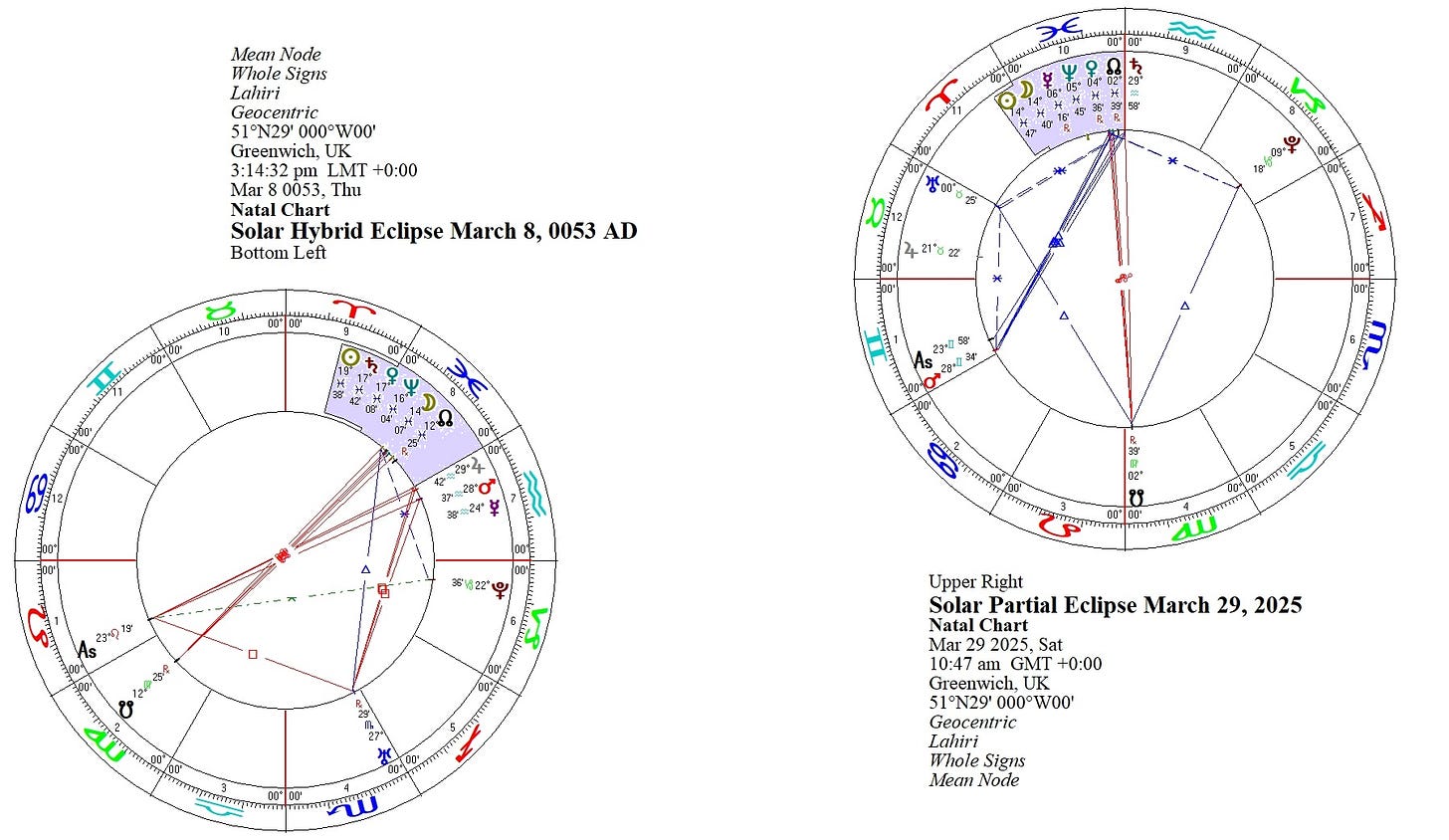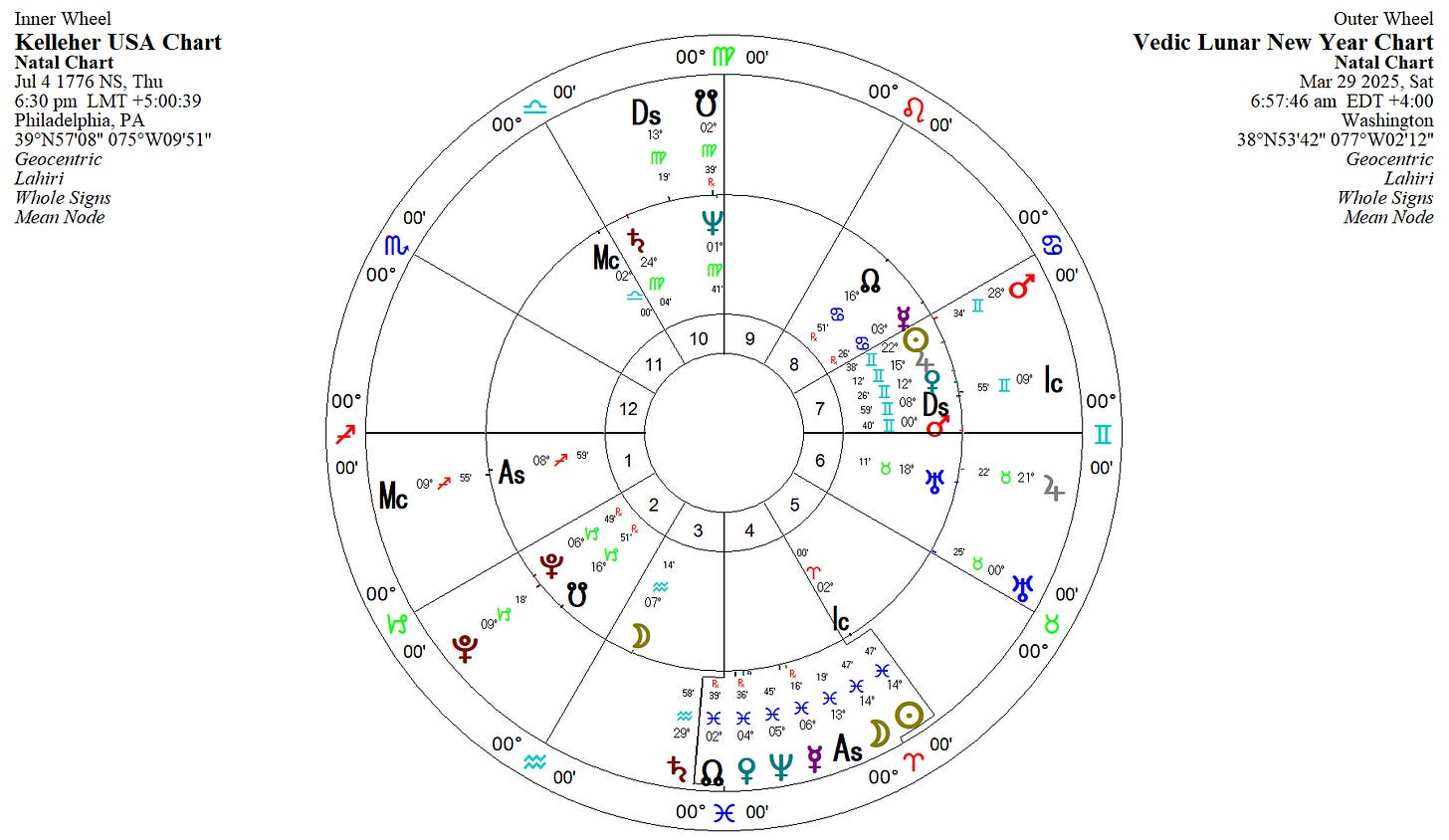The Astrology of the Solar Eclipse and the 2025 Vedic Lunar New Year
Why you should get ready for massive changes and unprecedented times in the year ahead
Happy New Year! Yes, I know it feels like we just welcomed in 2025, but in the Vedic world, the new year is just beginning. The 2025 Vedic Lunar New Year will start on March 29 this year in North and South America, and on March 30 elsewhere in the world. This is a special day in the Vedic calendar that celebrates the creative power of the Universe and the divinity within all of life.
Vedic Astrologers cast a special horoscope at this time to foretell some of the themes and events that may impact us during the year to come. In this article, I will look at this chart for the United States, and explain what we can expect in the new year to come. I will also discuss how a solar eclipse will make this new year especially significant.

A Partial Solar Eclipse Will Occur on the Vedic Lunar New Year: Changes and Dramatic Shifts Ahead
Before I analyze the new year chart, I need to discuss a special event that will occur when the next year begins. This new year, we will experience a rare solar eclipse. Every 18-19 years, a Rahu/North Node solar eclipse coincides with the Vedic Lunar New Year. This occurs when the Sun, Moon, and Rahu conjoin at the New Moon in Pisces.
Last year, we experienced a total solar eclipse during the new year. This Vedic new year will also occur coincidentally with a Rahu solar eclipse, but in this case it is a weaker type of solar eclipse (only a partial solar eclipse, rather than a total solar eclipse).
The statements I make in this article about the Vedic Lunar New Year horoscope will also apply to the horoscope for the solar eclipse, as they are one and the same. As these two events occur concurrently, this suggests another year of dramatic events, and a good deal of turmoil and tumult throughout the world. This will be especially true in areas where the eclipse will be visible, which are as follows, according to NASA:
The eclipse will be visible in parts of North America, Europe, Africa, northern Asia, small parts of South America, throughout Greenland and Iceland, as well as much of the Atlantic and Arctic oceans. In much of the Americas, including the northeastern United States, the partial solar eclipse will already be in progress during sunrise. In western Europe and northwestern Africa, the eclipse will begin in the mid-to-late morning. In eastern Europe and northern Asia, most or all of the eclipse will occur in the afternoon or early evening.

In my research of previous Rahu solar eclipses occurring in Pisces (at the Vedic Lunar New Year), I noticed a trend of unprecedented events. These kinds of events may include terrorist attacks, mass casualties and disasters (especially involving earthquakes, fires, floods, drownings, ships, waterways, planes, and oceans), political upheaval and assassinations (or assassination attempts), rebellions and riots, militarization and wars, and financial crises. These events may occur within a time range of six months before or after the solar eclipse.
I looked back to the last time we had a similar eclipse including Neptune, Saturn, Sun, Moon, Venus, and Rahu in Pisces, and it was in 53 AD (note that Mercury was not involved in that eclipse as it is now).
In 53 AD, the apostle Paul set out on his third mission to spread the Christian message. He traveled for about six years from Antioch (near present day Syria) through the areas that are now Türkiye, Greece, Lebanon, and Israel. Around the same time, the apostle Thomas traveled to the Malabar Coast of India to what is now modern-day Kerala, to spread the gospel of Christianity. So it seems there may be a spiritual resurgence in the world related to this current eclipse, as well.
Entering the Vishwavasu Year - A Year of Faith and Confidence
In addition to the influence of the partial eclipse, the current lunar cycle will impact us during the new year. The classic text known as Brihat Samhita by Sage Varahamihira states that there are 60 samvatsaras or lunar years that continue to cycle throughout time. These 60 years are organized into 12 groups of five. The current group of five years spans from 2022-2027, and the upcoming fourth year within this group of five is known as Vishwavasu Nama Samvatsara. This is the 39th of 60 samvatsaras. It will be in place from March 29, 2025 until March 19, 2026.
Each samvatsara has a particular essence that correlates with its Sanskrit name. Last year was a Krodhi year. The name translates as “angry and wrathful.” The Krodhi year is thus associated with aggression and violence, as well as lust, deceit, self-righteousness, arrogance, and greed.
As stated above, the new year will be a Vishwavasu Year. This year is said to bring some improvements after the difficult Krodhi year. It will not be perfect by any means, because we live within the realm of duality where we always have to face many conflicts and challenges.
Yet, the Vishwavasu Year refers to a year when we have the ability to be inspired with tremendous faith and confidence, and when there will be less anger and hatred than in the previous year. Jataka Parijata describes one born in this year as having a good sense of humor and being of high honor and rich in moral worth, and this can be translated to what we may all aspire to in the year itself.
Vedic Lunar New Year Chart - A Snapshot of the Next Twelve Months
Now that we have discussed the eclipse and lunar cycle, let’s take a look at the chart for the new year ahead. Different parts of the world will have their own Vedic Lunar New Year horoscopes based on their unique coordinates and time zones which change from place to place. Though the planets will be in the same signs, they will move into other houses as we transfer from one location to another. For my clients who live in different parts of the world, I often discuss the specific New Year chart for their particular regions. However, for my purposes here, I only have time to review the chart for the United States.
The Vedic Lunar New Year chart for each country is calculated when the New Moon occurs in Pisces, as seen from the location of the country’s capital. For instance, we use Washington, D.C. for the United States, where the New Moon will occur on March 29, 2025 at 6:57:46 AM. This occurs right before sunrise, so the Vedic New Year will begin on this day.
The New Moon/eclipse will occur in the First House in an intense and complicated Pisces stellium which gives mixed results. As mentioned before in this article and others, this stellium suggests that we are living in unprecedented times, both good and bad.
The Pisces New Moon/eclipse in the First House points to many important changes in the nation, much activity, and some great benefits to the nation’s citizens at large. The New Moon is conjoined two benefic planets Mercury and Venus. They are both retrograde, indicating that a little extra effort and time will be needed for their good fortune to manifest.
The mutual reception between Venus in Pisces and Jupiter in Taurus also suggests mixed results, including some prosperity and improvement in the affairs of the government and people, but also various threats and challenges that can make it difficult to deliver certain promised and desired results. These threats and challenges are further signified by the conjunction of Rahu, Saturn, and Neptune which I have discussed at length in several of my recent articles.
Additionally, the New Moon/eclipse in Pisces will occupy the fourth house of the United States Kelleher birth chart, as it also did last year. This emphasizes the potential new developments in transportation matters, infrastructure, land, real estate, agriculture, mines, minerals, immigration, possible natural and human-caused disasters, unusual weather patterns, and “socialistic agitation and trouble to the government,” according to Raphael’s Mundane Astrology.
Dominant Saturn and Sun Energy Throughout the Year
Saturn will have an especially strong impact in the United States this year. Saturn will be the King of the Year since it is the lord of the day (Saturday) when the New Moon in Pisces occurs in the United States. Saturn as the Lord of the Year has previously been associated with poor rainfall, corruption and crime, fires, and discontentment among some groups of the people. In my opinion, the fact that Saturn is entering the New Moon/eclipse axis five hours after the eclipse is a good sign of many positive changes ahead, which I have discussed in my previous article about Saturn’s Transit in Pisces.
The Sun will be the Prime Minister of the Year, also known as Mantri. The Prime Minister of the Year is the planet that rules the day when the Sun enters Aries (Mesha Sankranti). This event will occur on April 13 this year, which is a Sunday (the Sun’s day of the week). This is the chart for the Sun’s Aries ingress in the United States (Washington, DC).
The Mantri helps to oversee government and societal matters and serves under the pleasure of the King. When the Sun is the Mantri of the year, this also suggests similar issues that we see with Saturn as the King. The Sun and Saturn are enemies, and in their lower expression, their partnership may suggest some conflict and rebellion (power struggles). Yet, they can work together harmoniously when manifesting through their higher expression, in which case they represent a reality check and the need for a highly disciplined and focused approach to problem solving and long-term goals.
Navaratri: A Reason for Hope at the Beginning of the Vedic New Year
Vasant (or Chaitra) Navaratri always begins with the Vedic Lunar New Year. This is the nine-night spring festival of Devi Durga, who is worshiped as the deity of power, energy, and wisdom. She comes to bless and cleanse the world and all her devotees at this important turning point, to help us set off on the right foot as we begin the year anew.
Navaratri is a very auspicious period and time of growth and transformation for those who observe it. Navaratri celebrations will begin on March 29 in North and South America, and on March 30 elsewhere in the world. Prayers and pujas are performed to help remove misery and sorrow, and to bestow peace and well-being. On the ninth day (April 5 or 6 depending on your location), the celebration of Ram Navami will cap it all off. This is the precious day of Lord Ram’s birthday, which is celebrated as the victory of light over darkness, intelligence over ignorance, and good over evil.
As my analysis shows, the new year will bring great change, both beneficial and difficult. Although some of the harshness and challenging energy of the past should improve, we will need to focus on harnessing the potential that this new year brings us. Fortunately, Navaratri reminds us to celebrate the good in life and take a positive approach.
Happy New Year to all and may this new period bring you strength and happiness!










Asathoma Sat Gamaya
Juliana, Your forecast really seems to reflect what is going on in the world. It seems to be true that although this isn't the easiest of times, a higher good is likely to come from it all: there is a plan. Thank you for your perspective!